Embarking on a culinary adventure with a cast iron grill pan is akin to unlocking the gates to a realm where sizzling aromas dance tantalizingly, and flavors are seared into existence with every flip and turn.
Picture the scene: the robust weight of the pan in your hands, its seasoned surface whispering promises of perfectly charred meats and vibrant vegetables. As you embark on this journey, you’re not just cooking; you’re orchestrating a symphony of taste and texture.
Whether you’re a seasoned chef or an adventurous amateur, mastering the art of wielding a cast iron grill pan can elevate your culinary prowess to new heights. So, roll up your sleeves, fire up the stove, and let’s dive into the delicious world of cast iron grilling.
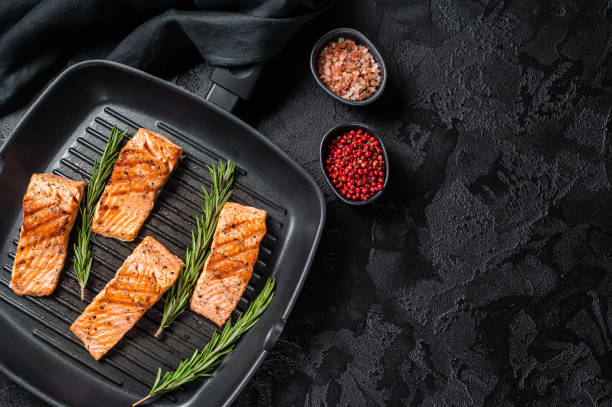
How To Use A Cast Iron Grill Pan
Using a cast iron grill pan can be a great way to achieve delicious grilled dishes indoors. Here’s a step-by-step guide on how to use one:
Preparation
- Begin by selecting the cast iron grill pan appropriate for your stove size and the quantity of food you intend to cook.
- Place the grill pan on the stove and ensure it sits flat and stable.
Seasoning (If Necessary)
- If your cast iron grill pan is not already seasoned, you’ll need to season it before use to prevent sticking and rusting. To season, coat the pan with a thin layer of vegetable oil or melted shortening, then bake it in an oven at 375°F (190°C) for about an hour. Allow it to cool before use.
Preheat the Grill Pan
- Turn on your stove to medium-high heat.
- Let the grill pan preheat for at least 5-10 minutes. It needs to be hot before you start cooking to ensure proper searing and grill marks.
Prepare Your Food
- While the grill pan is heating up, prepare the food you want to grill. This could be vegetables, meats, fish, or even fruits.
- Season your food as desired with herbs, spices, marinades, or rubs.
Oil the Grill Pan (Optional)
- Before adding the food, you may want to lightly oil the grill pan to prevent sticking. You can do this by brushing a thin layer of oil onto the pan’s surface using a silicone brush or a paper towel.
Grilling
- Once the grill pan is adequately heated, carefully place your food onto the hot grill surface.
- Allow the food to cook without disturbing it too much to achieve those coveted grill marks. Cooking times will vary depending on the type and thickness of the food.
Flipping
- After a few minutes, carefully lift the edge of the food to check for grill marks. Once you’re satisfied with the char, flip the food using tongs or a spatula.
- Continue cooking on the other side until it reaches your desired level of doneness.
Serve
- Once your food is cooked to perfection, remove it from the grill pan and transfer it to a serving plate.
- Allow the food to rest for a few minutes before serving to let the juices redistribute.
Cleaning
- After use, allow the grill pan to cool down completely.
- Clean the grill pan with hot water and a stiff brush. Avoid using soap, as it can remove the seasoning.
- Dry the grill pan thoroughly and lightly oil it before storing to prevent rust.
Maintenance
- Regularly maintain your cast iron grill pan by seasoning it periodically and storing it in a dry place to prevent rust.
By following these steps, you’ll be able to effectively use your cast iron grill pan to cook delicious grilled dishes indoors.
Why Do You Need A Cast Iron Grill Pan?
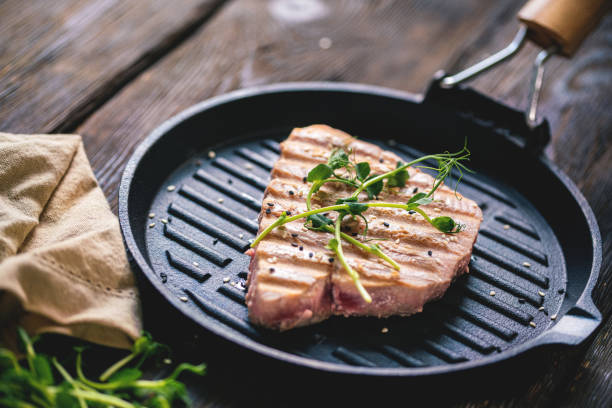
A cast iron grill pan offers several advantages that make it a valuable addition to your kitchen arsenal:
Indoor Grilling
Indoor grilling offers a convenient and versatile way to enjoy the flavors of grilled foods without the need for outdoor space or favorable weather conditions. Whether it’s raining, snowing, or simply inconvenient to set up an outdoor grill, indoor grilling provides a reliable alternative.
With the use of tools like a cast iron grill pan or electric grill, home chefs can replicate the delicious charred flavors and appealing grill marks on meats, vegetables, and seafood right in their kitchen.
Indoor grilling also allows for greater control over cooking temperatures, making it easier to achieve the desired level of doneness.
Indoor grilling can be a healthier option, as excess fats and oils can be drained away more effectively, and there’s less exposure to potentially harmful elements like charcoal smoke.
Overall, indoor grilling provides a convenient, practical, and enjoyable way to savor the taste of grilled dishes at any time of the year.
Versatility
The versatility of cooking options provided by a cast iron grill pan is unmatched in the kitchen. Beyond traditional grilling, this versatile tool enables chefs to explore various cooking techniques such as searing, sautéing, roasting, and even baking.
With its ability to distribute heat evenly and retain it effectively, a cast iron grill pan ensures consistent cooking results across a wide range of ingredients, from succulent meats to vibrant vegetables and delicate seafood.
Its ridged surface imparts appealing grill marks while allowing excess fats to drain away, promoting healthier cooking. Furthermore, the durability of cast iron means it can transition seamlessly from stovetop to oven, opening up a world of culinary possibilities.
Whether you’re whipping up a quick weeknight meal or showcasing your culinary skills for a special occasion, the versatility of a cast iron grill pan makes it an indispensable tool in any kitchen.
Excellent Heat Retention
The exceptional heat retention capabilities of a cast iron grill pan make it a standout choice for achieving perfectly cooked dishes with consistent results.
Cast iron’s ability to evenly distribute heat ensures that food cooks uniformly, without hot spots that can lead to uneven cooking. Once heated, the grill pan retains this heat effectively, allowing for sustained and controlled cooking, whether you’re searing thick steaks or grilling delicate vegetables.
This feature not only ensures efficient cooking but also enables the development of desirable caramelization and sear marks on the surface of the food, enhancing both flavor and presentation.
Whether you’re cooking on a gas, electric, or induction stove, the superior heat retention of a cast iron grill pan guarantees reliable performance and delicious results every time you fire it up.
Durability
The durability of a cast iron grill pan is legendary, making it a cherished tool in kitchens around the world. Constructed from solid cast iron, these pans are virtually indestructible and can withstand the rigors of daily use for decades.
Unlike other cookware materials that may warp, dent, or scratch easily, cast iron is robust and resilient, capable of enduring high heat and heavy-duty cooking techniques.
Whether you’re searing steaks, grilling burgers, or roasting vegetables, a cast iron grill pan can handle the heat without losing its shape or integrity.
With proper care and maintenance, including regular seasoning and cleaning, a cast iron grill pan can become even more durable over time, developing a natural non-stick surface that improves with each use.
Its longevity makes it a sustainable choice, reducing the need for frequent replacement and contributing to a more eco-friendly kitchen.
In essence, the durability of a cast iron grill pan ensures that it remains a steadfast companion in the culinary journey, ready to tackle any cooking challenge with unwavering reliability.
Healthy Cooking
Utilizing a cast iron grill pan promotes healthy cooking practices due to its unique properties. The pan’s surface, when properly seasoned, develops a natural non-stick coating, reducing the need for excessive oil or fat during cooking.
This feature allows for lighter and more health-conscious meal preparation, as it minimizes the calories and fats absorbed by the food. The ridged design of the grill pan allows excess fats and oils to drain away from the food as it cooks, further reducing the overall fat content of the dish.
Moreover, the even heat distribution of cast iron ensures that food cooks evenly and thoroughly without the need for prolonged cooking times, helping to retain essential nutrients and flavors.
As a result, using a cast iron grill pan offers a healthier approach to cooking without compromising on taste or texture, making it a valuable tool for health-conscious chefs.
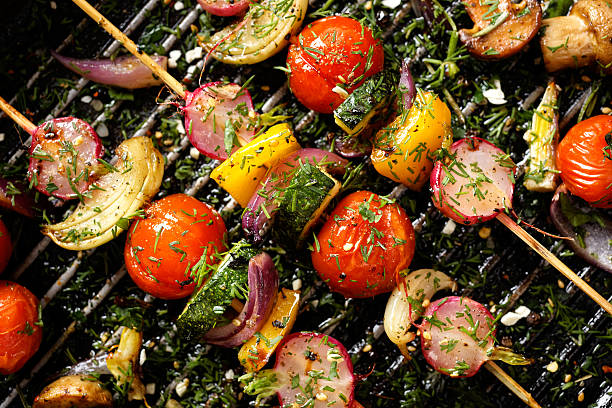
Flavor Enhancement
The use of a cast iron grill pan enhances the flavor profile of cooked dishes in remarkable ways. Thanks to its ability to evenly distribute and retain heat, the grill pan facilitates caramelization and Maillard reactions, resulting in rich, complex flavors and enticing aromas.
The ridged surface of the pan creates beautiful grill marks that not only enhance visual appeal but also contribute to a depth of flavor reminiscent of outdoor grilling. As the pan is seasoned with use, it imparts a subtle yet distinctive taste to the food, adding an extra layer of complexity to each dish.
Whether you’re grilling meats, vegetables, or even fruits, a cast iron grill pan elevates the flavor experience, turning ordinary meals into extraordinary culinary delights.
Cost-Effective
Investing in a cast iron grill pan is a cost-effective choice for any kitchen enthusiast. Unlike other cookware materials that may require frequent replacement due to wear and tear, a cast iron grill pan is built to last a lifetime with proper care.
Its durable construction ensures resistance to warping, scratching, and other forms of damage, saving you money in the long run by eliminating the need for frequent replacements.
Cast iron grill pans are relatively affordable compared to other high-quality cookware options, making them accessible to a wide range of budgets. With its versatility and longevity, a cast iron grill pan offers excellent value for money, providing countless delicious meals for years to come without breaking the bank.
Maintenance
Maintaining a cast iron grill pan is essential for preserving its longevity and performance. After each use, allow the pan to cool completely before cleaning to prevent thermal shock.
Clean the pan using hot water and a stiff brush to remove any food residues or stuck-on bits, avoiding the use of soap, which can strip away the pan’s seasoning. For stubborn residues, you can use kosher salt as a mild abrasive.
Once clean, dry the pan thoroughly with a towel to prevent rusting. To prevent corrosion and maintain the non-stick surface, it’s crucial to season the pan regularly.
To season, apply a thin layer of vegetable oil or melted shortening to the pan’s surface, including the handle, then place it upside down in an oven preheated to 375°F (190°C) for about an hour. Let it cool before storing.
Store the pan in a dry place to prevent rust formation. With proper maintenance, your cast iron grill pan will continue to provide excellent cooking results for years to come.
Troubleshooting and Maintenance Tips
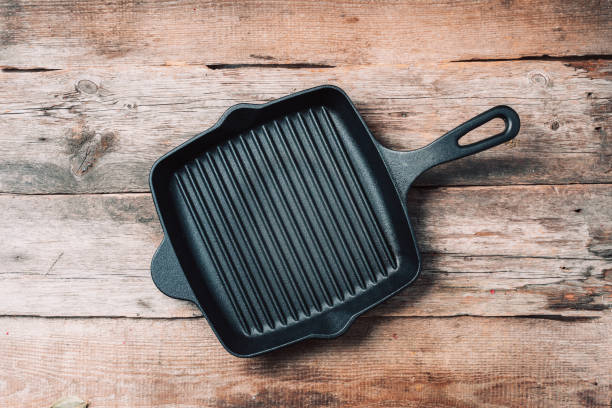
Troubleshooting and maintenance are crucial aspects of ensuring your cast iron grill pan performs optimally and lasts for generations. Here are some tips to troubleshoot common issues and maintain your pan effectively:
Sticking Food
If food is sticking to the pan, it may be due to inadequate seasoning or improper heating. Ensure the pan is properly seasoned by applying a thin layer of oil after each use and baking it in the oven. Additionally, preheat the pan thoroughly before adding food to create a natural non-stick surface.
Rust Formation
Rust can occur if the pan is not dried thoroughly after cleaning or if it’s stored in a damp environment. To remove rust, scrub the affected areas with a mixture of equal parts water and vinegar, then rinse and dry the pan thoroughly. Re-season the pan as needed to prevent future rusting.
Uneven Cooking
Uneven cooking may result from hot spots on the pan’s surface or improper heat distribution. To address this issue, preheat the pan evenly and rotate the food during cooking to ensure even heat exposure. If hot spots persist, consider using a diffuser or adjusting your stove’s heat settings.
Smoke and Odors
Excessive smoke or odors during cooking can be caused by residue buildup or inadequate seasoning. Clean the pan thoroughly after each use to remove any food residues and prevent odors. If smoke persists, reduce the heat or ventilate the kitchen properly.
Handle Maintenance
The handle of your cast iron grill pan may loosen over time due to repeated heating and cooling. Check the handle regularly and tighten any loose screws or bolts. If the handle becomes damaged, consider replacing it to prevent accidents.
Storage
Proper storage is essential to prevent damage and rusting. Store the pan in a dry place with good airflow to prevent moisture buildup. Consider placing a paper towel or cloth between stacked pans to absorb any excess moisture and prevent scratching.
Safety Precautions and Cleaning Guidelines
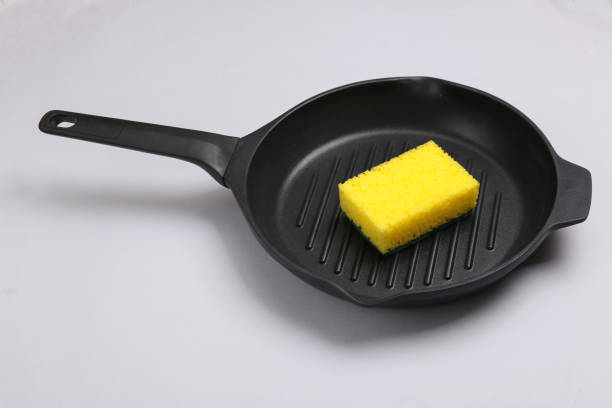
Safety precautions and proper cleaning guidelines are essential for maintaining the functionality and longevity of your cast iron grill pan while ensuring safe cooking practices. Here’s a comprehensive guide:
Safety Precautions
- Handle with Care: Cast iron grill pans can become very hot during cooking. Always use oven mitts or pot holders when handling the pan, especially when moving it from the stovetop or oven.
- Avoid Overheating: While cast iron is durable, it can crack if exposed to sudden temperature changes. Avoid placing a hot pan under cold water or onto a cold surface. Allow it to cool gradually before cleaning or moving.
- Use Adequate Ventilation: Grilling indoors can produce smoke and odors. Ensure proper ventilation by using an exhaust fan or opening windows to prevent smoke buildup in your kitchen.
- Watch for Spills: Be cautious of any spills or drips that may occur during cooking, as they can cause burns if they come into contact with skin.
- Keep Away from Children: Cast iron grill pans are heavy and can cause injury if dropped. Store them in a secure location out of reach of children to prevent accidents.
Cleaning Guidelines
- Cooling Down: Allow the pan to cool down completely before cleaning to prevent burns.
- Hand Wash Only: Avoid using soap, as it can strip away the seasoning. Instead, clean the pan with hot water and a stiff brush or sponge. For stubborn residues, use kosher salt as a mild abrasive.
- Avoid Soaking: Do not soak a cast iron grill pan in water, as prolonged exposure to moisture can cause rusting. If necessary, soak it briefly to loosen stubborn food particles, then dry it thoroughly.
- Dry Immediately: After cleaning, dry the pan thoroughly with a towel to prevent rust formation. Place it on the stovetop over low heat for a few minutes to ensure all moisture evaporates.
- Re-season Regularly: To maintain the non-stick surface and prevent rust, re-season the pan regularly. Apply a thin layer of vegetable oil or melted shortening to the pan’s surface, including the handle, then bake it in the oven upside down at 375°F (190°C) for about an hour. Allow it to cool before storing.
By following these safety precautions and cleaning guidelines, you can ensure the safe and proper use of your cast iron grill pan while preserving its quality and performance for years to come.
Advanced Techniques and Pro Tips

Advanced techniques and pro tips can elevate your cooking with a cast iron grill pan to the next level, unlocking new flavors and textures. Here are some advanced techniques and tips to help you make the most of your cast iron grill pan:
Dual Cooking Methods
Experiment with combining different cooking methods for optimal results. For example, sear a steak on the grill pan to create charred exterior then finish it in the oven for even cooking.
Flavor Infusion
Enhance the flavor of your dishes by adding aromatics such as garlic, herbs, or citrus zest to the pan while cooking. The heat will release their flavors, infusing the food with delicious nuances.
Marinate for Depth
Marinating your proteins before grilling can add layers of flavor and tenderize tougher cuts of meat. Opt for acidic marinades with ingredients like citrus juice, vinegar, or yogurt to break down proteins and enhance tenderness.
Preheat for Perfect Grill Marks
Achieve restaurant-quality grill marks by preheating your cast iron grill pan thoroughly. Place it on the stove over medium-high heat for at least 10-15 minutes before adding your food.
Pressing Technique
Use a cast iron grill press or a heavy skillet to apply pressure to your food while cooking. This technique helps achieve even contact with the grill pan, resulting in better searing and more pronounced grill marks.
Smoking with Wood Chips
Infuse your dishes with smoky flavors by adding soaked wood chips to your cast iron grill pan before cooking. Simply place the soaked chips in a foil packet and poke holes in it to release the smoke while grilling.
Grill Pan Lid
Invest in a grill pan lid or improvise with a heatproof lid or foil to trap heat and steam, promoting even cooking and faster cooking times, especially for thicker cuts of meat.
Resting Period
Allow your grilled foods to rest for a few minutes after cooking before slicing or serving. This allows the juices to redistribute evenly throughout the meat, resulting in juicier and more flavorful dishes.
Cleaning Stubborn Stains
For stubborn stains or residue, create a paste using baking soda and water, and gently scrub the pan with a soft brush or sponge. Avoid harsh abrasives or metal utensils that can damage the seasoning.
Continuous Learning
Keep experimenting with different ingredients, marinades, and techniques to expand your culinary repertoire and discover new ways to maximize the potential of your cast iron grill pan.
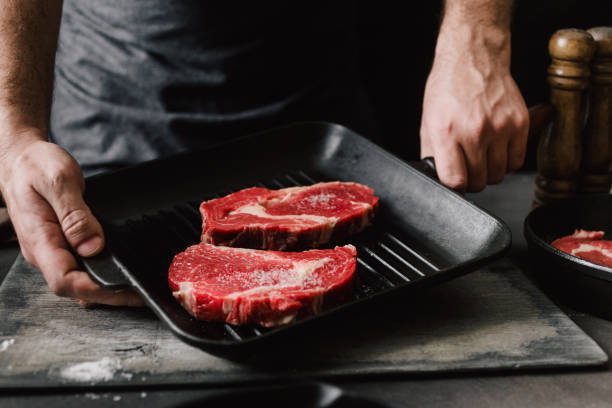
Frequently Asked Questions (FAQs) – How To Use A Cast Iron Grill Pan
How can I achieve those beautiful grill marks on my food using a cast iron grill pan?
You can easily achieve those coveted grill marks by preheating your cast iron grill pan on medium-high heat until it’s hot, then placing your food directly on the ridges and letting it sear for a few minutes before flipping.
I’m new to using a cast iron grill pan, how do I prevent food from sticking?
A simple trick to prevent sticking is to ensure your pan is well-seasoned and properly preheated before adding any food. Also, lightly coat your food with oil or marinade to create a barrier between the pan and the food.
What are the benefits of using a cast iron grill pan compared to other types of cookware?
Cast iron grill pans are excellent for searing and creating those beautiful grill marks, and they also distribute heat evenly, resulting in perfectly cooked food every time. Additionally, they can be used on the stove, in the oven, or even on the grill, offering versatility and convenience.
I’ve heard that cast iron requires special care, is it difficult to maintain?
While cast iron does require some care, it’s actually quite simple to maintain. Regularly seasoning your pan and avoiding harsh soaps will keep it in great condition for years to come. Plus, the more you use it, the better it gets!
Can I use a cast iron grill pan on different types of stoves?
Yes, absolutely! Cast iron grill pans are incredibly versatile and can be used on gas, electric, and even induction stoves. Just make sure your pan is compatible with your stove type and always follow the manufacturer’s guidelines.
I’ve heard that cast iron cookware can increase iron intake, is this true for grill pans too?
Yes, it’s true! Cooking with cast iron can actually boost your iron intake, which is especially beneficial for individuals with iron deficiency. So not only are you cooking delicious meals, but you’re also getting a little nutritional boost along the way.
Is it safe to use metal utensils on a cast iron grill pan?
Absolutely! Cast iron is incredibly durable, so you can confidently use metal utensils without worrying about damaging the surface. Just be sure to avoid scraping too vigorously to preserve the seasoning.
How do I clean my cast iron grill pan without removing the seasoning?
Cleaning a cast iron grill pan is easier than you might think! Simply use hot water and a stiff brush to remove any food residue, then dry it thoroughly with a towel. Avoid using soap, as it can strip away the seasoning. If needed, you can also use kosher salt as a gentle abrasive.
Can I cook acidic foods like tomatoes or citrus on a cast iron grill pan?
Absolutely! Cast iron is incredibly versatile and can handle acidic foods without any issues. Just be sure to avoid prolonged exposure to acidic ingredients, as it can potentially affect the seasoning over time.
Conclusion
In conclusion, mastering the art of using a cast iron grill pan opens up a world of culinary possibilities, bringing the joys of outdoor grilling indoors.
By following the steps outlined and incorporating tips for maintenance and care, anyone can achieve delicious, perfectly seared dishes with distinct grill marks and mouthwatering flavor profiles.
Embracing the versatility of a cast iron grill pan not only enhances cooking experiences but also promotes healthier cooking methods while preserving the rich heritage of cast iron cookware.
So, fire up the stove, season your pan, and let the sizzle of your favorite ingredients on a cast iron grill pan inspire your culinary creativity for years to come.
Related Posts: